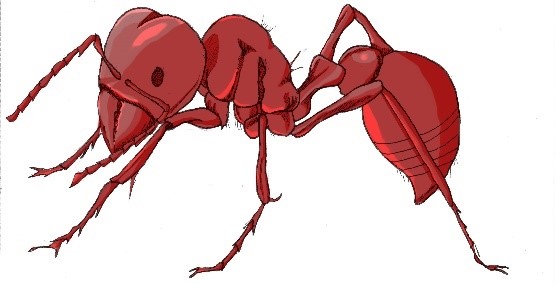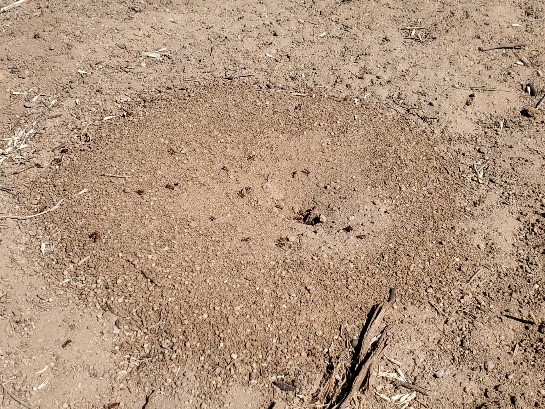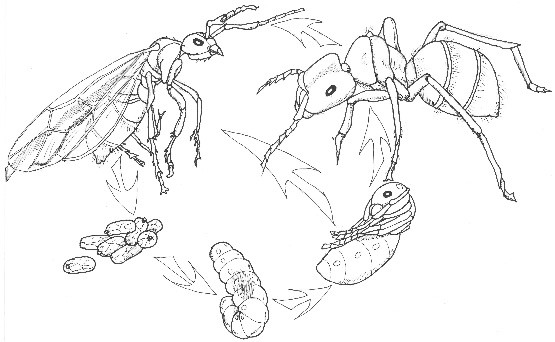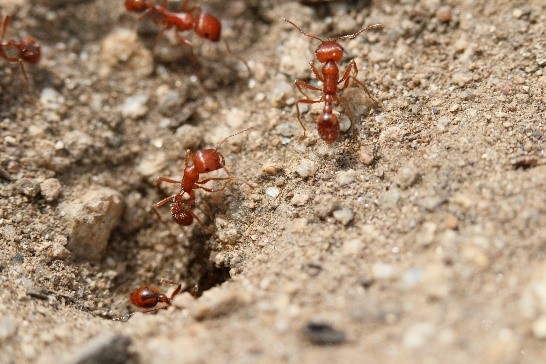Common names: Harvester ant, harvesting ants
Scientific name: Pogonomyrmex spp.
Description:
There are 22 different species of harvester ants found in the United States. Harvester ants can come in a variety of colors, ranging from black to brown to red, with an average size of 1/5 to 1/2 inch long. When looking closely at the body, two nodes can be seen between the abdomen and thorax. Their nests are quite noticeable, as they are bare circular patches of soil that can get as large as 12 feet in diameter and 3 feet deep. A small mound may form of pebbles, soil and sand that the ants have expertly excavated to create a network of tunnels and chambers underneath the surface. Harvester ants are often confused with fire ants, but fire ants are much smaller and will be darker in color on their abdomen when compared to the head. Adult harvester ants at certain times of the year will have four clear wings that have amber colored veins.
 Harvester ant illustration. Illustration by James Schwarz.
Harvester ant illustration. Illustration by James Schwarz.
 Harvest ant hill. Photo by Wendy Hanson Mazet.
Harvest ant hill. Photo by Wendy Hanson Mazet.
Behavior:
In nature, harvester ants play an important role, helping to disperse seeds, increasing the porosity of soil and being a food source for other animals. Harvester ants are least active during mid-day due to the increased temperature.
Life cycle:
Ants have four major life stages: egg, larva, pupa and adult. In the summer, swarms of winged ants can be seen. The swarms consist of males and new queens that are going to mate. After mating, the males die, while the females lose their wings and start a new nest. After the first eggs have hatched, they become larvae that eat and grow before pupating. After pupating, the ants become adult worker ants. These worker ants will then forage for seeds and take care of the larvae, helping grow the population of the colony. A single colony of harvester ants can survive for 15 to 20 years.
 The typical back of a pesticide container may include directions for use, first aid information, storage and disposal instructions, precautionary statements, and the EPA registration number.
The typical back of a pesticide container may include directions for use, first aid information, storage and disposal instructions, precautionary statements, and the EPA registration number.
Diet and damage:
Harvester ants are largely seed feeders, although they will occasionally eat other dead insects. If their nest is disturbed, harvester ants will defend their nest and sting the person or animal that has disturbed it. Allergic reactions to these stings are uncommon but not unheard of, and anyone who is allergic to other insect stings should be cautious. Stings often feel similar to a bee sting. Harvester ants do not invade homes, but they can occasionally be pests in lawns, gardens and pet areas.
 Photo of harvester ant in natural habitat. Photo by James Marfleet, stock.adobe.com.
Photo of harvester ant in natural habitat. Photo by James Marfleet, stock.adobe.com.
Monitoring:
By being observant of the ant’s behavior, you can find their nest, which is one of their most identifying features. If possible, it is best to leave harvester ant nests alone; they are mostly harmless to people and can be beneficial to the surrounding environment. Remove harvester ant nests if children or pets are often in the surrounding area to prevent them from being stung. Help with identification is available by contacting your local Extension office.
Cultural and mechanical control:
Regularly mowing or discing the area surrounding the nest can help reduce the population of ants and deter them from further nesting in the area. In addition, research has shown that nests that become shaded by plants or human activity often leave the area.
Biological control:
Birds and lizards are helpful friends in helping control harvester ant populations. There are no known applied biological control methods.
Chemical control:
Specific lawn-labeled granular ant baits can be placed around the nest to help reduce populations. Diatomaceous earth can also be applied to the area surrounding a nest. Both of these control methods take time to work, with results seen after two weeks. When applying a pesticide, read the entire product label thoroughly before application.


